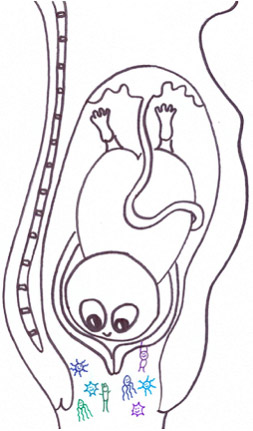At birth, our digestive tract is sterile meaning it does not contain bacteria. It is during the birthing process that our digestive tract becomes colonized by bacteria from the mother’s vagina, colon, and rectum.
Let’s compare this to a Baby Born by C-Section
Since babies delivered by caesarean do not go through the birth canal, they are not exposed to the same diversity of bacteria. However, these babies will be in contact with the skin’s bacteria, which is more exposed to the outside world and this then increases the chances of the baby encountering pathogens (things that can cause diseases).
 The second obstacle these babies encounter is that they struggle to keep up with babies born through the natural birthing processes in terms of the development of healthy bacterial levels. Bacteria can create a new generation in just about 20 minutes, but the amount of different types of bacteria is also important. This bacterial diversity is much more difficult to develop if a baby starts off with fewer types.
The second obstacle these babies encounter is that they struggle to keep up with babies born through the natural birthing processes in terms of the development of healthy bacterial levels. Bacteria can create a new generation in just about 20 minutes, but the amount of different types of bacteria is also important. This bacterial diversity is much more difficult to develop if a baby starts off with fewer types.
Thanks to regular contact/breastfeeding with their mother, babies are able to grow healthy gut environments.
The risk, if this doesn’t go well, is a weak immune system; did you know that about 80% of your immune system lives in your guts?
A slow introduction of new food is important as babies’ digestive tracts are quite permeable, and can allow non-digested protein to make its way through the intestinal wall. This can result in potential allergic reactions or auto-immune disease in the future, as studies have found poor gut flora to be a possible factor of both allergies and certain diseases.
If the mother takes antibiotics during pregnancy, or if babies are given antibiotics during their first year of life, it can also be extremely difficult on the child’s gut flora, and, sometimes even pose an increased risk for the baby/child to develop asthma as they grow.
The environment of the child (living in a city, excessive cleanliness, diet, etc.) will also affect the strength of his/her immune system; but the microbiome will continue to change up into adulthood.
Now, you can better understand the different factors influencing your child’s health. You can also help by making sure no inflammation is lingering in your child’s intestines (because of allergies, or sensitivities), and by supplementing, if necessary, with probiotics or fermented food.
Osteopathy might be helpful, too!
By working on the different organs that recycle waste out of our body, we can strengthen their function: giving more power to the “garbage-man” of the body and narrowing down the exact part of your internal organs that needs help. Each patient is different, and it would be an ineffective shortcut to describe exactly what your child’s treatment would be without consultation. But, our goal is to balance the structure of the body: is the pelvis tilted? Are some vertebrae in dysfunction? Is the vagus nerve responsible for the digestive tract not working properly?…, and to make sure that all organs are doing what they are supposed to do.
The moral of this story is that the disease/symptoms are a sign, but not always the cause of the problem. An osteopath will look into the whole body to find the root of the problem, and so should you!
If you would like help with this, consider booking an Osteopathic therapy appointment with myself, here.
